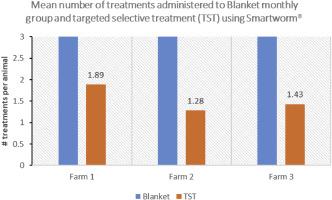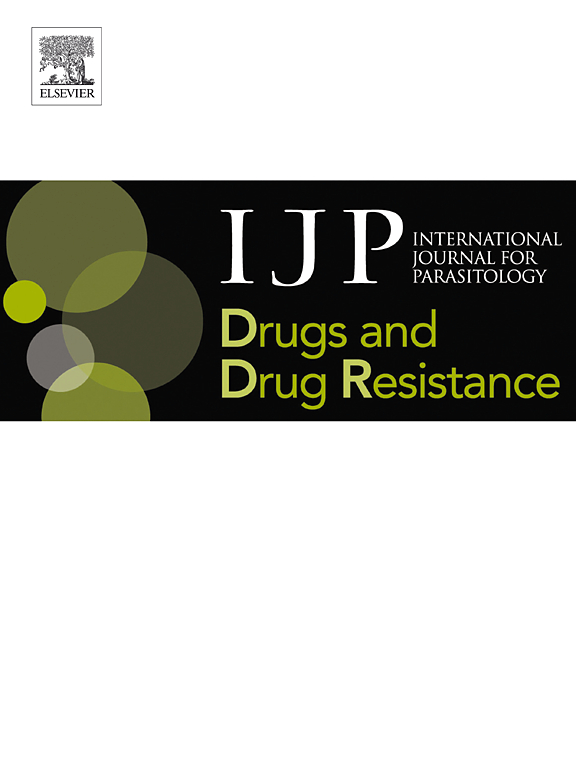试用SmartWorm®在新西兰羊农场的应用
IF 3.4
2区 医学
Q1 PARASITOLOGY
International Journal for Parasitology: Drugs and Drug Resistance
Pub Date : 2025-09-24
DOI:10.1016/j.ijpddr.2025.100616
引用次数: 0
摘要
胃肠道线虫(GIN)仍然是全球放牧牲畜面临的主要健康和生产力挑战,包括新西兰,据报道该国广泛存在抗虫性。这是一项评估SmartWorm®有效性的试点研究,SmartWorm®是一种基于应用程序的决策支持工具,用于针对内部寄生虫进行针对性选择治疗(TST),以减少雨水的使用,同时不影响新西兰条件下羔羊的生长。来自三个商业农场的1738只母羊被分配到TST组或一揽子处理组(每28天处理一次),并在90天内进行监测。在试验开始时,所有动物都被淋湿,之后BT动物在随后的每次称重时接受治疗。SmartWorm用于根据个体动物相对于预期的生产性能来确定TST动物的浇水需求。评估粪卵计数(FEC)、体重增加和治疗频率。在所有农场中,与BT相比,TST减少了37 - 57%的驱虫剂使用,但在活重增加方面没有显著差异(P = 0.510)。BT组FEC与TST率呈线性关系(R2 = 0.8951, P < 0.001,剔除1个异常值),表明系统对寄生虫攻击的响应性较好。这项研究表明,使用该应用程序实施TST可以在不影响性能的情况下减少驱虫剂的使用,这是新西兰羊场朝着可持续寄生虫管理迈出的重要一步。本文章由计算机程序翻译,如有差异,请以英文原文为准。

Trialling the SmartWorm® application in New Zealand sheep farms
Gastrointestinal nematodes (GIN) remain a major health and productivity challenge for grazing livestock globally, including New Zealand where widespread anthelmintic resistance has been reported. This was a pilot study evaluating the effectiveness of SmartWorm®, an app-based decision-support tool for Targeted Selective Treatment (TST) of internal parasites to reduce drench use without compromising lamb growth under New Zealand conditions.
A total of 1738 ewe lambs across three commercial farms were allocated to either a TST or Blanket Treatment (BT) group (treated every 28 days) and monitored over a 90-day period. All animals were drenched at the start of the trial, after which BT animals received treatment at each subsequent weighing. SmartWorm was used to determine drenching need for TST animals based on individual animal performance relative to expectation. Faecal egg counts (FEC), weight gain, and treatment frequency were assessed.
Across all farms, TST reduced anthelmintic use by 37–57 % compared with BT, with no significant differences in liveweight gain (P = 0.510). There was a weak but significant treatment effect on FEC (P = 0.01), and a linear relationship (R2 = 0.8951, P < 0.001 with one outlier removed) between BT group FEC and TST rate, indicating the system's responsiveness to parasite challenge.
This study demonstrates that implementing TST using this app can enable reduced anthelmintic use without compromising performance—an important step towards sustainable parasite management on New Zealand sheep farms.
求助全文
通过发布文献求助,成功后即可免费获取论文全文。
去求助
来源期刊

International Journal for Parasitology: Drugs and Drug Resistance
PARASITOLOGY-PHARMACOLOGY & PHARMACY
CiteScore
7.90
自引率
7.50%
发文量
31
审稿时长
48 days
期刊介绍:
The International Journal for Parasitology – Drugs and Drug Resistance is one of a series of specialist, open access journals launched by the International Journal for Parasitology. It publishes the results of original research in the area of anti-parasite drug identification, development and evaluation, and parasite drug resistance. The journal also covers research into natural products as anti-parasitic agents, and bioactive parasite products. Studies can be aimed at unicellular or multicellular parasites of human or veterinary importance.
 求助内容:
求助内容: 应助结果提醒方式:
应助结果提醒方式:


